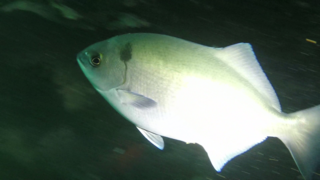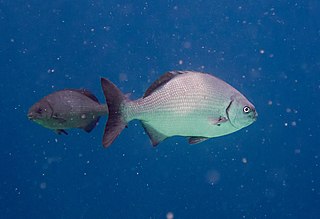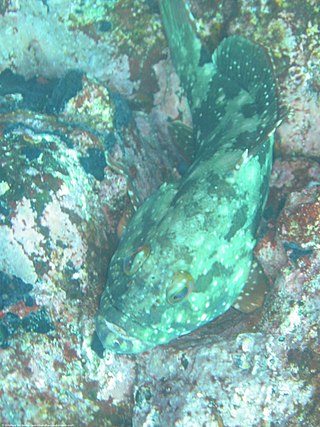
The halfmoon, also known as the blue perch, is a species of marine ray-finned fish, a sea chub from the subfamily Scorpidinae, part of the family Kyphosidae. It is native to the coasts of the eastern Pacific Ocean off western North America. It is fished for using hook and line and it is a desirable food fish.

The blue maomao, also known as the violet sweep, blue sweep or hardbelly, is a species of marine ray-finned fish, a member of the subfamily Scorpidinae, part of the sea chub family Kyphosidae. It is native to the southwestern Pacific Ocean from Australia to New Zealand and the Kermadec Islands, where it can be found in inshore waters from the surface to depths of 30 m (98 ft). This fish can reach a length of 40 cm (16 in). It is commercially important and is also a popular game fish.

The silver drummer, also known as the buff bream, buffalo bream, buffs, common buffalo bream, drummer bream, Southern silver drummer or Sydney drummer, is a species of marine ray-finned fish, a sea chub from the family Kyphosidae. It is found in the southeastern Indian Ocean and the southwestern Pacific Ocean off Australia and New Zealand where it is found in shallow water near rocky reefs.

The Microcanthinae, commonly known as footballers, mados, stripeys, and moonlighters, are a subfamily of the sea chubs, a family of marine ray-finned fish in the order Perciformes.

The giant hawkfish, also known as the hieroglyphic hawkfish, is a species of marine ray-finned fish, a hawkfish belonging to the family Cirrhitidae. It is a marine fish and the largest of the hawkfish family with maximum size of 60 cm (24 in) in total length. It is found in the eastern Pacific Ocean.

Kyphosus sectatrix, the Bermuda chub, Pacific drummer, beaked chub, grey drummer, Pacific chub or white chub, is a species of marine ray-finned fish, a sea chub from the family Kyphosidae. This species is found in tropical and subtropical coastal waters worldwide. It has had a confused taxonomic history dating back to Linnaeus's naming of the species in 1758.

The sooty grunter, also known by the name black bream, blubberlips, Northern grunter or purple grunter, is a species of freshwater ray-finned fish, a grunter from the family Terapontidae. It inhabits coastal and inland freshwater creeks and rivers of northern Australia.
The Gladius sea chub is a species of marine ray-finned fish, a sea chub in the family Kyphosidae. It was recognised a new species in 2013 and is found in the southeastern Indian Ocean where endemic to the southern coasts of Western Australia.

Epinephelus labriformis, commonly called starry grouper or flag cabrilla is a species of marine ray-finned fish, a grouper from the subfamily Epinephelinae which is part of the family Serranidae, which also includes the anthias and sea basses. It is found in the eastern Pacific Ocean.

Kyphosus azureus, the zebra-perch sea chub, zebra perch or zebra sea chub, is a species of marine ray-finned fish, a sea chub from the family Kyphosidae which is native to the eastern Pacific Ocean coasts of North America.

Kyphosus is a genus of sea chubs native to the Atlantic, Indian and Pacific oceans. It is the only genus in the subfamily Kyphosinae of the family Kyphosidae.

The stripey, also known as the footballer or convict fish, is a species of ray-finned fish, a sea chub from the subfamily Microcanthinae which is part of the family Kyphosidae. It is native to the Pacific Ocean where it has a wide range. This species may be found in the aquarium trade.

Kyphosus ocyurus, the blue-striped chub or rainbow chub, is a species of marine ray-finned fish, a sea chub from the family Kyphosidae. The species is found in the Pacific Ocean where it prefers rocky substrates.

Girella elevata, the rock blackfish, Eastern rock blackfish, black rockfish or Eastern rock blackfish drummer is a species of marine ray-finned fish, a sea chub from the family Kyphosidae. It is found in the southwestern Pacific Ocean around eastern Australia and northern New Zealand.

Girella zebra, also known as zebrafish or stripey bream, is a species of marine ray-finned fish, a sea chub in the family Kyphosidae. It lives in the Indo-Pacific, where it is endemic to the coastal waters of the southern parts of Australia.

Kyphosus bigibbus, the brown chub, grey drummer, darkfin drummer, insular rudderfish, grey chub, grey sea chub, southern drummer or topsail drummer is a species of marine ray-finned fish, a sea chub from the family Kyphosidae. It is a herbivorous species which is found in subtropical and tropical seas worldwide.

Kyphosus vaigiensis, the brassy chub, brassy drummer, long-finned drummer, low-finned drummer, Northern silver drummer, Queensland drummer, Southern drummer, blue-bronze sea chub, brassy rudderfish, yellow seachub, large-tailed drummer, low-finned chub or long-finned rudderfish, is a species of marine ray-finned fish, a sea chub from the family Kyphosidae. It is a largely herbivorous species which has a circumglobal distribution. Studies in the 21st Century appear to have shown that some other species in the genus Kyphosus are junior synonyms of this taxon.

Kyphosus cinerascens is a species of marine ray-finned fish. It is a sea chub from the family Kyphosidae. Kyphosus Cinerascens has 11 dorsal fins and 12 anal fins. Kyphosus cinerascens are widely distributed in the Indo-Pacific region. The Kyphosus cinerascens has a strict diet on phaeophytes, chlorophytes, and rhodophytes, making them herbivores.

Kyphosus cornelii, the Western buffalo bream, Cornel's drummer or the Western drummer, is a species of marine ray-finned fish, a sea chub belonging to the family Kyphosidae. It is endemic to Western Australia.

The Hawaiian chub, also known as the insular rudderfish or bicolor chub, is a species of marine ray-finned fish, a sea chub belonging to the family Kyphosidae. This species is found in the Central Pacific Ocean.



















